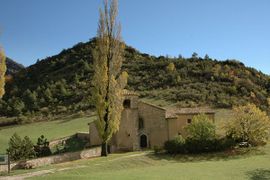Rochefourchat
Lua error in package.lua at line 80: module 'strict' not found.
| Rochefourchat | |
|---|---|
 |
|
| Coordinates: Lua error in package.lua at line 80: module 'strict' not found. | |
| Country | France |
| Region | Auvergne-Rhône-Alpes |
| Department | Drôme |
| Arrondissement | Die |
| Canton | La Motte-Chalancon |
| Government | |
| • Mayor (2008–2014) | Jean-Baptiste Le Moyne de Martigny |
| Area1 | 12.74 km2 (4.92 sq mi) |
| Population (2008)2 | 1 |
| • Density | 0.078/km2 (0.20/sq mi) |
| INSEE/Postal code | 26274 / 26340 |
| Elevation | 600–1,513 m (1,969–4,964 ft) (avg. 963 m or 3,159 ft) |
| 1 French Land Register data, which excludes lakes, ponds, glaciers > 1 km² (0.386 sq mi or 247 acres) and river estuaries. 2 Population without double counting: residents of multiple communes (e.g., students and military personnel) only counted once. | |
Rochefourchat is a commune in the Drôme department in the Rhône-Alpes region in southeastern France. In the commune there is a single house, a converted barn, and the ruins of an old castle. The nearest communes to Rochefourchat are Saint-Nazaire-le-Désert, Les Tonils, Pradelle, and Brette.
History
In 1178, the castle of Rocha Forcha was built by the bishops of the arrondissement of Die as a stronghold against the Holy Roman Emperors. It belonged to French lords until the year 1766 when the last one, Lord Rey de Noinville, died. In 1796, a French trader, Pierre Jossaud bought the land surrounding the castle and renamed it Rochefourchat. The commune has been passed down through Jossaud's family.
Population
| Historical population | ||
|---|---|---|
| Year | Pop. | ±% |
| 1806 | 221 | — |
| 1911 | 64 | −71.0% |
| 1950 | 31 | −51.6% |
| 1962 | 14 | −54.8% |
| 1968 | 6 | −57.1% |
| 1975 | 2 | −66.7% |
| 1982 | 3 | +50.0% |
| 1990 | 2 | −33.3% |
| 1999 | 1 | −50.0% |
| 2008 | 1 | +0.0% |
There is only one permanent inhabitant, making it the least populous French commune.
See also
References
External links
| Wikimedia Commons has media related to Rochefourchat. |

